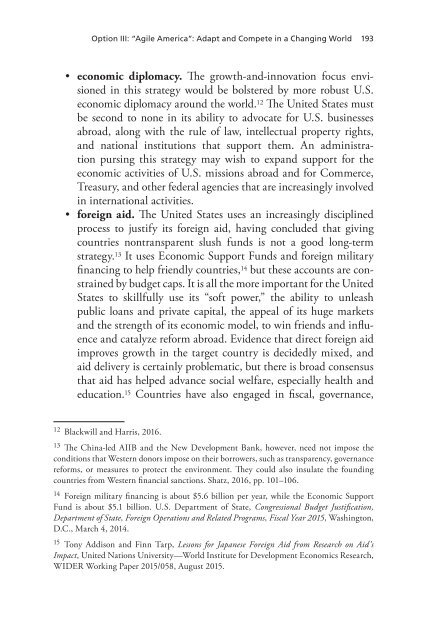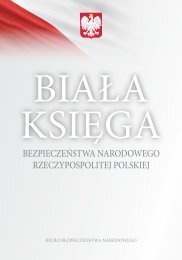You also want an ePaper? Increase the reach of your titles
YUMPU automatically turns print PDFs into web optimized ePapers that Google loves.
Option III: “Agile America”: Adapt and Compete in a Changing World 193<br />
• economic diplomacy. The growth-and-innovation focus envisioned<br />
in this strategy would be bolstered by more robust U.S.<br />
economic diplomacy around the world. 12 The United States must<br />
be second to none in its ability to advocate for U.S. businesses<br />
abroad, along with the rule of law, intellectual property rights,<br />
and national institutions that support them. An administration<br />
pursing this strategy may wish to expand support for the<br />
economic activities of U.S. missions abroad and for Commerce,<br />
Treasury, and other federal agencies that are increasingly involved<br />
in international activities.<br />
• foreign aid. The United States uses an increasingly disciplined<br />
process to justify its foreign aid, having concluded that giving<br />
countries nontransparent slush funds is not a good long-term<br />
strategy. 13 It uses Economic Support Funds and foreign military<br />
financing to help friendly countries, 14 but these accounts are constrained<br />
by budget caps. It is all the more important for the United<br />
States to skillfully use its “soft power,” the ability to unleash<br />
public loans and private capital, the appeal of its huge markets<br />
and the strength of its economic model, to win friends and influence<br />
and catalyze reform abroad. Evidence that direct foreign aid<br />
improves growth in the target country is decidedly mixed, and<br />
aid delivery is certainly problematic, but there is broad consensus<br />
that aid has helped advance social welfare, especially health and<br />
education. 15 Countries have also engaged in fiscal, governance,<br />
12 Blackwill and Harris, 2016.<br />
13 The China-led AIIB and the New Development Bank, however, need not impose the<br />
conditions that Western donors impose on their borrowers, such as transparency, governance<br />
reforms, or measures to protect the environment. They could also insulate the founding<br />
countries from Western financial sanctions. Shatz, 2016, pp. 101–106.<br />
14 Foreign military financing is about $5.6 billion per year, while the Economic Support<br />
Fund is about $5.1 billion. U.S. Department of State, Congressional Budget Justification,<br />
Department of State, Foreign Operations and Related Programs, Fiscal Year 2015, Washington,<br />
D.C., March 4, 2014.<br />
15 Tony Addison and Finn Tarp, Lessons for Japanese Foreign Aid from Research on Aid’s<br />
Impact, United Nations University—World Institute for Development Economics Research,<br />
WIDER Working Paper 2015/058, August 2015.




